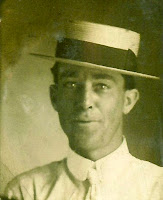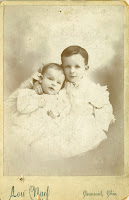Thomas Charles Gaffney (1874 – 1937)
Cora Alice (Terrill) Gaffney (1879 – 1951)
Agnes Evelyn (Gaffney) Johnson (1902 – 1977)
Ernest F.W. Johnson (1900 – 1958)
Last of a four part series
 |
| Agnes Evelyn Gaffney |
Unlike her parents Thomas and Cora (Terrill) Gaffney, Agnes Evelyn (Gaffney) Johnson seems to have enjoyed a loving and stable marriage with her husband Ernest but remained childless as far as the records show.
I cannot find anyone by that her name in her mother’s family but suspect she was named after her father’s sister, Agnes Gaffney. The photographs we saw yesterday of Agnes and her parents on cousin Benita McGinnis‘ engagement day suggest they were close enough to gather together for celebrations and special occasions. Add to this that before 1940, Agnes and Ernest moved into a house on Mill Street in Conneaut, Ohio, just two doors down from her paternal aunt, Frances (Gaffney) Cherry, and we can conclude that she got along well with her Gaffney relatives.
The 1950s brought sadness to Agnes’ life as she began losing several members of her family. Her mother Cora died in Monroe in 1951 at age 72, and several of the Gaffney aunts died in the years that followed. Ernest Johnson died the day after Thanksgiving on November 28, 1958. Agnes would have been 56 at the time, barely two years younger than her husband.
By then, many of the younger Gaffneys had already left Conneaut for bigger cities. With so many of them gone, it is no surprise that Agnes eventually left, too. Some of the Gaffney cousins had moved south to the warmer climes of Florida, and she might have wanted to move there to be near them in her old age.
The bread crumb trail of records is broken abruptly for nearly two decades between the time of Ernest’s passing and Agnes’ own death at age 75. It would be nice to know what her life was like during that time.
The Social Security Death Index does give us a clue. It indicates that she received her Social Security Number 1951 through the Railroad Board. She had worked as an office clerk for a railroad company back in 1940 and most likely retired between the late 1950s or early 1960s before moving to Florida.
Until this point (except for during her early childhood when she moved back and forth between several cities with her mother), Agnes lived in Conneaut most of her life. The move to such a different and distant area for a small town girl was a major change for her, especially as a widow. If she had the affable Gaffney personality, though, she should have had no problems making new friends.
 |
| Agnes Evelyn (Gaffney) Johnson – from the scrapbook of Benita (McGinnis) McCormick, year unknown |
The Social Security Death Index also notes that Agnes’ last residence was in Fort Lauderdale, the same city in which she died on September 4, 1977.
Agnes’ body was returned to Conneaut, where she was buried next to her husband in Glenwood Cemetery.
People are not one-dimensional creatures, and everyone has a story. Some people’s stories are harder to find than others. My mother once said she hoped she would not be remembered as “just another name on a family tree, hanging precariously from some obscure branch” of the family tree. I think most of us would agree. All of us deserve to be remembered for more than just our names.
The story of Tommy Gaffney started out as a scant trail of breadcrumbs as I tried to learn what was behind this practical joker and happy-g0-lucky man so beloved by his family. The more crumbs I found, the more they seemed to follow a trail of the twists and turns that all of us experience in our lives. They led us to discover new people and revealed aspects of his life we might never have expected or imagined.
As we reach the end of this trail of bread crumbs of the life of the colorful Tommy that led us to learn more about him and discover his wife and daughter, I wish I could meet them, if only to say how glad and grateful I am to have learned about them.
There might be more waiting around the bend to discover about the Gaffney family, but other ancestors patiently await their turn. For now, we shall say farewell to this wonderful family until we return to visit another day.
Part Two: What the Records Can and Can’t Tell Us
Part Three: Wishful Wednesday: Happy and Not So Happy Endings















